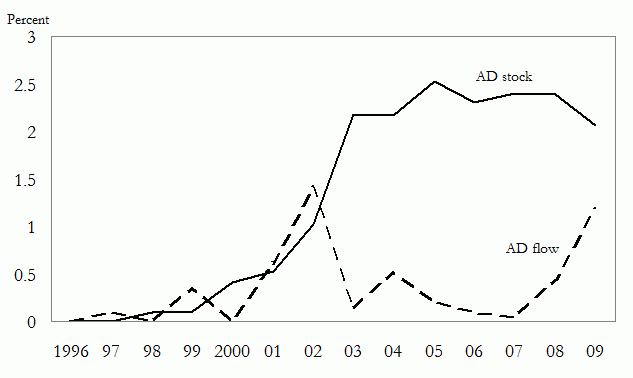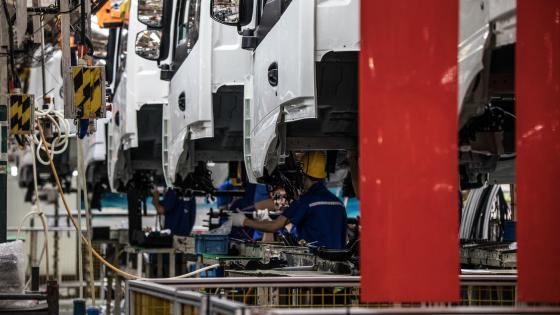As tariffs have decreased around the world, many countries have started using other contingent measures of protection, such as antidumping duties, countervailing duties, and safeguards. China too had a period of dramatic tariff liberalisation, with its average tariff decreasing substantially from roughly 40% in 1993 to about 17% in 2000. As it entered the WTO in December 2001, its average applied tariffs declined further. However, during this period China also started using temporary trade protection, primarily in the form of antidumping duties (Messerlin 2004; Bown 2010).
China enacted its first antidumping laws in 1997 and started new investigations in the same year. By the end of 2009, it had initiated 172 separate cases. In Chandra (2011), I explore China's imposition of antidumping duties and other temporary trade barriers during 1997-2009 in further detail by taking into account both new initiations as well as the existing stock of antidumping orders. I examine its composition across sectors, the groups of foreign countries that China has targeted, and the time duration of the measures imposed, and I explore whether there have been any changes in its use during the recent global economic crisis, 2008-9.
Several key facts emerge from the analysis.
- The global economic crisis coincided with an increase in new AD investigations by China, reversing the trend from previous years.
This pattern holds under a number of different metrics, whether we consider the number of antidumping cases, the share of products involved, or the share of China’s import value affected. Figures 1a and 1b show China's antidumping use against developed and developing countries, respectively.
Figure 1. Share of import value affected by antidumping duties
Source: Chandra (2011). The dashed line shows the flow of new AD investigations in China, whereas the solid line refers to the stock of all AD measures in force. The graphs are based on a slightly modified version of equation 2 from Bown (2011) where I restrict the calculations to only the targeted group.
The time trend in the new investigations reveals a similar pattern across both groups of countries. There was a remarkable increase in the value of imports subject to new investigations in 2002, compared to earlier periods. Since 2003, new investigations continued to decline until 2007; however, starting in 2008, this number again began to go up.
- In 2009 alone, roughly 1.2% of China's imports from developed countries were subject to new investigations.
- China’s antidumping duties have disproportionally targeted high-income countries.
At the peak period in 2003, only around 1.8% of China's imports from the developing countries were subject to an antidumping measure. This is in contrast to roughly 2.5% of imports from developed countries being subject to a measure in 2005. Similarly, only 0.4% of imports from developing countries were subject to a new investigation in 2009, in contrast to 1.2% of imports from developed countries.
- Despite the increase in new investigations during the crisis years, the total stock of imports subject to antidumping decreased as several existing measures were removed during this period.
Moreover, the new measures imposed by China targeted lower-value imports compared to those being removed.
Sectoral composition and the duration of antidumping
Next, we explore the sectoral composition of China's antidumping investigations.
- Almost all of China's investigations were restricted to only five sectors - chemicals, paper and pulp, plastics and rubber, steel, and textiles.
However, during the crisis China initiated new investigations in some sectors such as animal products and transport equipment. The chemicals sector has dominated China's antidumping activities in terms of the number of investigations, filing 104 of the 172 (60%) cases during 1997-2009.
- While chemicals dominated antidumping activities in count data, the share of products affected by antidumping in chemicals is comparable to the other leading sectors that initiated many fewer cases.
For instance, at its within-period peak in 2008, China had imposed an antidumping measure on about 8.6% of the total stock of imports in the chemicals sector. This is comparable to the within-period peak of 7.4% in the case of steel, a sector with 10 times fewer antidumping cases.
Another important feature of China's antidumping regime is the duration of its antidumping measures. Although China removed a number of measures during the crisis period, the duration of previously-imposed measures surpassed five years without removal in many cases. As of end 2009, 60% of the cases that had lasted for more than five years had not yet been removed.
Though I focus on antidumping, as China has primarily used that instrument so far, it also initiated three countervailing duties investigations in 2009. Thus, if the above trends are to continue, I would expect to see the temporary trade barriers play a bigger role in increasing import barriers in China.
References
Bown, Chad P. (2010), “China’s WTO Entry: Antidumping, Safeguards, and Dispute Settlement”, in Robert Feenstra and Shang-Jin Wei, editors, China’s Growing Role in World Trade. Chicago, IL: University of Chicago Press and NBER.
Bown, Chad P. (2011b), “Taking Stock of Antidumping, Safeguards, and Countervailing Duties, 1990-2009”, The World Economy, forthcoming.
Chandra, Piyush (2011) “China: A Sleeping Giant of Temporary Trade Barriers?”, in Chad P. Bown, editor, The Great Recession and Import Protection: The Role of Temporary Trade Barriers. London, UK: CEPR and the World Bank.
Messerlin, Patrick A. (2004), “China in the World Trade Organisation: Antidumping and Safeguards”, World Bank Economic Review 18(1), 105–130.



